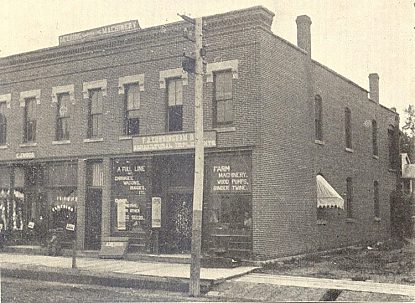
 This
photo also shows the Grand Opera House and, across the alley, the
Cunningham building. Built in 1869 by E. B. Alderman and Dexter
Cunningham, the building housed Capt. Alderman's agricultural implement
business. He was bought out by Cunningham. F. J. Cunningham followed
Dexter and eventually S. McLaughlin operated a harness shop there. The
east room of the building housed E. J. Wood's clothing store which was
replaced by Crawford Clothing Co. The Good Templars had their lodge on
the second floor.
This
photo also shows the Grand Opera House and, across the alley, the
Cunningham building. Built in 1869 by E. B. Alderman and Dexter
Cunningham, the building housed Capt. Alderman's agricultural implement
business. He was bought out by Cunningham. F. J. Cunningham followed
Dexter and eventually S. McLaughlin operated a harness shop there. The
east room of the building housed E. J. Wood's clothing store which was
replaced by Crawford Clothing Co. The Good Templars had their lodge on
the second floor.
The small building between Cunningham's and the
1904 Post Office is the 1875 Post Office. It was built by W. S. Benton
after fire destroyed the previous location on the north side of Main
Street. The building was also occupied by G. W. Strode, a jeweler and
watch and clock repairman. In 1881, the building was sold to a tailor,
William Shaw. (Not the William T. Shaw mentioned elsewhere.)
 The
1904 Post Office was at the corner of Main and Booth on the former site
of the Congregational Church built in the 1860s. The Post Office
Department contracted with George L. Schoonover to construct the
building of brick trimmed with blue Bedford stone. The furnishings,
designed by a Mr. Schipkowsky, were manufactured at the Welch Factory in
Anamosa.
The
1904 Post Office was at the corner of Main and Booth on the former site
of the Congregational Church built in the 1860s. The Post Office
Department contracted with George L. Schoonover to construct the
building of brick trimmed with blue Bedford stone. The furnishings,
designed by a Mr. Schipkowsky, were manufactured at the Welch Factory in
Anamosa.
The east side of the main floor of the building was
occupied by the Post Office and included 500 boxes. The west side housed
A. G. Gibbons & Co., Cash Pharmacy. This was sold to Frank Stoughton in
1916. It became a Rexall and eventually Hawley's drug store operated by
Courtright Hawley. I wonder if it had a soda fountain?
The second
floor was occupied by Judge Davis McCarn, Park Chamberlain, and Dr. H.
W. Sigworth & Sons.